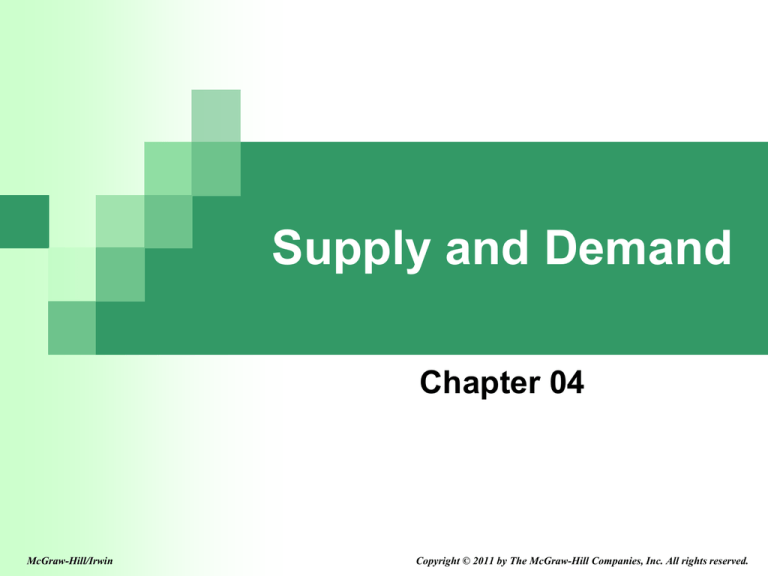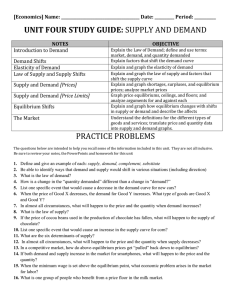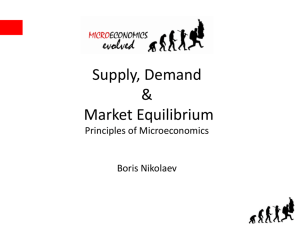
Supply and Demand
Chapter 04
McGraw-Hill/Irwin
Copyright © 2011 by The McGraw-Hill Companies, Inc. All rights reserved.
Learning Objectives
In this chapter you’ll learn how to:
1.
2.
3.
4.
5.
6.
7.
Define and explain demand in a product or service market.
Define and explain supply.
Determine the equilibrium point in the market for a specific good,
given data on supply and demand at different price levels.
Explain what causes shifts in demand and supply.
Explain how price ceilings cause shortages.
Explain how price floors cause surpluses.
Apply supply and demand analysis to real-world problems.
4-2
Demand
Is the schedule of quantities of a good or service that
people are willing and able to buy at different prices.
•
Sometimes a schedule is also called a table.
Demand shows how much quantity of a good or
service can be sold at different prices.
People pay for goods or services according to how
many benefits those goods or services will yield.
Generally less quantity will be demanded as prices
increase since people will find relatively less
expensive substitutes to provide similar levels of
benefits.
4-3
Demand Schedule and Curve
To graph, plot one set
of points at a time.
Begin with P = $500
and Q = 1,000
Table 1
Price
QD
$500
1,000
450
3,000
400
7,000
350
12,000
300
19,000
250
30,000
200
45,000
150
57,000
100
67,000
4-4
Supply
Is the schedule of quantities of a good or service that
people are willing to sell at different prices.
In general, the higher the price, the more of a good or
service individuals are willing to supply. As price
increases so does quantity provided.
This happens because different producers face
different opportunity costs and as the price increases
or decreases, producing a good or service becomes
more or less attractive to producers at the margin.
4-5
Supply Schedule and Curve
To graph, plot one set of
points at a time.
Price
$500
$450
$400
$350
$300
$250
$200
$150
$100
Begin with P = $100
and Q = 2,000
QS
62,000
59,000
54,000
48,000
40,000
30,000
16,000
7,000
2,000
4-6
Equilibrium
Equilibrium price is the price at which quantity demanded
equals quantity supplied or QD = QS.
A surplus occurs when the market price is above
equilibrium price.
A shortage occurs when the market price is below
equilibrium price.
4-7
A Picture of Equilibrium
Equilibrium occurs at the
point where supply crosses
demand.
If price were higher than
equilibrium, more producers
would want to produce goods
or services than consumers
would want to consume.
•
QS > QD
If the price were lower, more
consumers would want to
consume goods or services
than producers would want to
produce.
•
QD > QS
4-8
Shifts in Demand
A change in the price of a good or service moves us
along a given demand schedule/curve.
•
Movement up or down the same curve.
A change in the demand schedule results in a shift of the
demand schedule/curve.
•
If consumer preferences change for whatever reason, that will
shift the demand curve either outward or inward depending upon
the nature of the change.
4-9
Demand Curve Shifts Outward
When a demand curve shifts
outward, people are willing to
buy more goods or services
at each possible price.
Preferences (willingness) or
income (ability to pay) can
change.
If perceived benefits
increase, people will pay
more.
If more people want to fly to
visit family at Thanksgiving
than at other times, we
expect an outward shift.
D1 shifts to the right to D2.
4-10
Demand Curve Shifts Inward
When a demand curve shifts
inward, people are willing to
buy fewer goods at previous
prices.
Preferences or ability to pay
may change.
If there is a severe economic
downturn and fewer people
are taking business trips, we
would expect an inward shift
of the demand curve.
On the graph on the right, a
recession would also lead to a
lower demand in a product
like a video game.
4-11
Questions for Thought and Discussion
Why do markets show that people demand fewer goods
at higher prices?
What would happen to demand for the various services
and products under the following scenarios? Will the
curve shift and in which direction?
•
•
•
Oprah Winfrey expresses concern about mad cow disease and
beef. What happens to the demand for hamburgers?
The National Institutes of Health releases a study that shows
Vitamin D reduces the probability of getting cancer. What
happens to demand for Vitamin D?
The manufacturers of Frisbees discover a new, less expensive
polymer to make Frisbees. What happens to the demand for
Frisbees?
4-12
Shifts in Supply
Changes in the demand schedule (consumer behavior)
or changes in price move us along an existing supply
schedule.
Changes in the cost of factors of production or increases
in productivity shift the supply curve.
4-13
Supply Shift Outward
When a supply curve shifts
outward, businesses are
willing to supply the same
amount that they did before
the shift at lower price
levels.
Improvements in
technology, lower resource
costs, or higher factor
productivity can result in
this sort of shift.
If the price of jet fuel
decreases, this would
result in an outward shift in
the supply curve of airline
flights.
S1 shifts to the right to S2.
4-14
Supply Curve Shift Inward
When a supply curve shifts
inward, businesses will only
supply what they did before
the shift at higher prices.
As costs change for
businesses, opportunity
costs change.
If the cost of jet fuel rises,
that would shift the supply
curve for airline flights
inward to the left.
On the graph on the right,
an increase in costs of
grapes would lead to a
lower supply of bottles of
wine.
4-15
Shift in Demand and Equilibrium
If there are shifts in demand
or supply, a new equilibrium
point will be found on the
basis of new perceived
benefits or changes in costs.
Demand 2
Price
(monthly bill)
Supply
140
120
100
In this instance, a demanddriven increase for the new
iPhone pushes price up and
the quantity of subscriptions
up.
80
60
Demand
5
10
15
20
25
30
Quantity
(Millions of
I Phone
Subscribers)
4-16
Shift in Supply and Equilibrium
If there are shifts in demand
or supply, a new equilibrium
point will be found on the
basis of new perceived
benefits or changes in costs.
In this instance, there is a
shift in supply.
What happens to equilibrium
price and quantity?
4-17
Questions for Thought and Discussion
Why is equilibrium thought to be efficient?
What happens if price is not at an equilibrium point?
What do prices represent to producers and consumers?
4-18
Government and the Market
The government may ensure the smooth operation of
the markets by protecting property rights,
guaranteeing enforcement of legal contracts, and
issuing a supply of money (currency) that buyers and
sellers readily accept.
Government sometimes changes market outcomes by
•
•
Imposing prices floors and price ceilings.
This may create problems of shortages and surpluses.
While governmental interference with the market
system can have adverse affects, the government
does have a substantial supportive role to play in a
market economy.
4-19
Price Floors
Sometimes producers feel
the price they are getting for
their product is too low.
They may lobby the
government to put in a price
floor.
A price floor results in a
surplus being supplied at the
higher price.
Suppliers end up supplying
more than consumers want to
buy.
Examples: wheat and corn
prices; federal minimum
wage.
How do you think price floors for
agricultural commodities would
impact the market for these
commodities?
4-20
Price Ceilings
Sometimes buyers do not like
the price they need to pay for
a good or service.
Buyers may lobby
government to put a price
cap on what sellers can
charge.
Classic example: rent controlled apartments.
When rent control is in place
producers can not charge a
price above the ceiling.
4-21
Rent Control: The Institution People
Love to Hate
People who live in rent-controlled properties get
their apartments at bargain prices.
People looking for apartments will have a harder
time finding them and will have to put up with more
inconveniences in the housing market because rent
control reduces the incentives of business people to
provide quality housing options.
Rent control can misallocate a scarce resource
(housing) to people who value the resource less
than market value.
From a policy standpoint, who is helped or hurt by
rent control? Why does the local government have
this policy in some U.S. cities?
4-22
Application of Supply and Demand:
Interest Rate Determination
Interest rates are also set by
supply and demand.
It is the market for loanable
funds.
Suppliers are banks, mortgage
companies, credit unions, etc.
Demanders are homeowners
and businesses, for example.
In the graph on the right, what
is the equilibrium interest rate?
How much money is
lent/borrowed?
4-23
Application of Supply and Demand:
Shifts in Interest Rates
What would happen to the interest rate and funds lent/borrowed
when supply increases? When demand increases?
4-24
Further Applications of Supply and Demand:
Questions for Thought and Discussion
Should parking be free at your school?
Would a parking fee eliminate the shortage?
If the price of gasoline increased to $8 a gallon, would
you cut back on your driving?
Explain how prices are a signal to producers about
consumer preferences.
4-25
Gasoline Markets and Price: Hurricane
Katrina Case Study
On Labor Day weekend of 2005, Hurricane Katrina:
•
•
•
•
•
•
Temporarily shut down off-shore wells in the Gulf of Mexico.
Briefly put 10% of our refineries out of commission.
Result: A sudden drop in oil supply.
The government took a “hands off” approach.
Gasoline prices rose sharply.
People could buy all they wanted at sharply increased prices with
no wait at the pumps.
What happened after the BP oil spill caused by the
explosion of the Deep Water Horizon oil rig in the Gulf of
Mexico in April of 2010?
4-26
Closing Comments
Most economists probably believe price ceilings do more
harm than good in the long run.
Most people probably think in the short run and want
government to do something about higher prices.
Government probably is inclined to get involved.
Corporate greed probably can and will influence
government actions.
4-27
Questions for Thought and Discussion
How is equilibrium price affected by changes in demand?
By changes in supply?
If you were a landlord, would you be against rent control?
Do corporations have incentives to lobby the government
for price floors or ceilings?
Practical Application: Urban highways are usually
congested during morning and evening commuting times.
Using supply and demand analysis, what simple step
could be taken to greatly reduce congestion?
4-28










